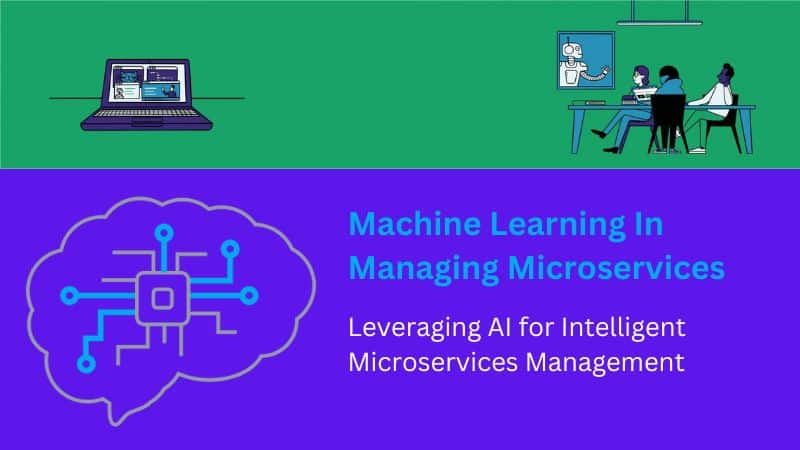Machine learning and artificial intelligence (AI) have grown persistent and changed the way we network with technology. Technological advancements are altering entire industries, and by extension, our daily lives.
Microservices management is one domain where they are really shining. This article will delve into the various machine learning algorithms used, the advantages of employing AI in this context, the role of machine learning in microservices management, and best practices for utilizing AI in this context.
The Function of Machine Learning in Managing Microservices
The scalability and flexibility of microservices software development Company that arranges an application as a series of loosely linked services—have contributed to their rising popularity. Nevertheless, it might be difficult to adequately manage these distributed services. In this context, machine learning is useful. Microservices management may be optimized and automated with the help of AI algorithms, which improves performance and makes the user experience even better.
The monitoring and fault detection of microservices is one of the critical areas where machine learning has an impact. In order to find trends and outliers, machine learning algorithms can sift through mountains of data gained from different microservices. Artificial intelligence (AI) can detect problems, forecast breakdowns, and take corrective measures to avoid interruptions in service by constantly scanning the system. By proactively addressing maintenance issues, downtime is reduced and microservices are guaranteed to work smoothly.
Machine learning can be useful for allocating resources and predicting workloads. AI algorithms can foretell future workload requirements by looking at past data and taking things like user behavior trends and system performance standards into account. We can make sure that every microservice has the processing power it needs to react to requests by efficiently allocating resources with this data. Efficient and waste-free resource allocation in real-time.
Advantages of use of Artificial Intelligence to Microservices Administration
Using artificial intelligence (AI) into microservices management improves the system’s performance. Some of the most important benefits are:
- Improved fault detection and prevention: Machine learning algorithms can recognize patterns and outliers in real time, enabling proactive problem avoidance and improved fault detection. This guarantees that services are available continuously and minimizes downtime.
- Enhanced system performance: System performance is improved because AI algorithms can analyze past data and forecast future workload demands, allowing for more efficient deployment of resources. System performance and response times are optimized.
- Scalability and flexibility: Both scalability and flexibility are hallmarks of microservices architectures. By automating the administration of microservices, AI improves these qualities making the system more flexible to meet evolving demands.
- Cost optimization: Artificial intelligence (AI) optimizes costs by reducing resource wastage through intelligent resource allocation and workload prediction. Artificial intelligence also saves time and money by automating many management processes, which means less human intervention is required.
- Enhancement of the user experience: AI guarantees a problem-free experience by actively identifying and fixing system performance issues. Higher levels of satisfaction are achieved when users experience uninterrupted service availability and fast response times.
Methods for Managing Microservices Using Machine Learning
In order to optimize system performance and automate various operations, microservices management makes use of several machine learning methods. Here are a few algorithms that are frequently utilized:
- Supervised learning:
In supervised learning, a model is trained using labeled data such that the system can classify or predict new data that has not yet been seen. In managing microservices, supervised learning is useful for things like fault detection and workload prediction.
- Unsupervised learning:
Unsupervised learning: This type of learning does not rely on labeled data as supervised learning does. Contrarily, it finds patterns and outliers by analyzing unlabeled data. Anomaly detection in microservices is one example of a task that can benefit from unsupervised learning.
- Reinforcement learning:
With reinforcement learning, the algorithm receives feedback on its actions and learns from its mistakes. For managing microservices, reinforcement learning can help with things like workload balancing and resource allocation.
- Deep learning.
A subfield of machine learning, known as “deep learning” makes use of multi-layered artificial neural networks. Complex pattern identification and analysis jobs are where this algorithm really shines. Applications like sentiment analysis and natural language processing can benefit from deep learning for microservices management.
Applying AI to the Administration of Microservices
A lot of thought and preparation goes into using AI for microservices management. A few important considerations are:
- Gathering and cleaning data.
In order to train AI models well, it is essential to use data of good quality. Gather pertinent information from different microservices and clean it up beforehand. This guarantees that the data fed into the AI algorithms is correct and trustworthy.
- Choosing the right algorithm.
The correct algorithm should be chosen because various machine learning jobs call for distinct approaches to microservices management. Consider the specifics of each job while deciding the algorithm to use. To identify the optimal match, it may be required to conduct experiments and tests.
- Establishing and assessing models.
The preprocessed data can then train the chosen machine learning models. Use suitable metrics to assess the models’ performance and make adjustments as needed. Keep the models up-to-date and retrained so they can adjust to the ever-changing dynamics of the system.
- Connectivity to pre-existing infrastructures.
The AI-driven microservices management solution must be integrated with the current tools and infrastructure. The AI system and the rest of the microservices architecture must be compatible and communicate with each other with no hitches.
- Continuous monitoring and improvement.
If you want your AI system to work as intended once you install it, you need to monitor it. To create the required changes and enhancements, gather user data and feedback. Because of AI systems’ inherent capacity to learn and develop, constant vigilance and tweaking are required.
Effective Ways to Use AI for Managing Microservices
Here are some tips for making the most of AI in managing microservices:
- Make tiny steps and keep trying: To gauge AI’s efficacy, start with a small project or microservice. Get a feel for how things work, then tweak the implementation to add support for additional microservices as you go.
- Work together: Developers, data scientists, and operations teams, among others, must work together to integrate AI into microservices management. To guarantee a smooth transition and widespread use, encourage an atmosphere of teamwork and information exchange.
- Establish clear goals and metrics: The AI-powered microservices management system needs well-defined objectives and measures of success. In order to monitor development and find problem areas, it is necessary to establish standards and then measure the system’s performance against this metrics ongoing.
- Keep everything open and easy to understand: Because of their complexity, AI algorithms are often seen as mysterious black boxes. Make sure the AI system can be explained by recording and sharing its decision-making procedures. The result is an increase in mutual trust and comprehension among all parties involved.
- Stay up-to-date: Because AI methods and tools are always developing, it’s important to keep up with the latest news and developments. Keep yourself updated on the newest developments in the industry and investigate their potential applications to microservices management. The key to making the most of AI is to constantly learn and adapt.
New Trends in Artificial Intelligence for Managing Microservices
Artificial intelligence (AI) as it pertains to microservices management is a dynamic area that is always developing and seeing recent developments. Among the upcoming changes to monitor are:
- Adapting to fluctuating needs in real-time and minimizing the need for human intervention, auto-scaling and self-healing systems can be further automated with the help of AI algorithms for microservices.
- The necessity for AI systems to be explained grows in direct proportion to the complexity of these systems. The goal of future AI research and development might be to create models that can explain their choices and behaviors that humans can comprehend and trust.
- Training machine learning models on dispersed data sources without sending data to a central location is possible with federated learning. Because it keeps data private and cuts down on transmission cost, this method can be useful for microservices administration.
- Anomaly detection systems powered by artificial intelligence will keep getting better, allowing for faster and more precise identification of suspicious activity in microservices. The ability to detect and prevent faults will be substantially improved.
Final Thoughts
How distributed systems are built and maintained might be radically altered by incorporating AI and machine learning into microservices administration. Microservices architectures can achieve better speed, scalability, and flexibility by utilizing AI algorithms for fault detection, workload prediction, and resource allocation. Optimizing costs, improving the user experience, and proactively preventing faults are all advantages of utilizing AI in microservices management. Organizations may completely harness the power of AI in microservices management and realize its full potential by adhering to best practices, maintaining updates on breakthroughs, and working across teams. With developments like auto-scaling systems and explainable AI on the way, the future of artificial intelligence in microservices management is looking bright.




It seems like you’re repeating a set of comments that you might have come across on various websites or social media platforms. These comments typically include praise for the content, requests for improvement, and expressions of gratitude. Is there anything specific you’d like to discuss or inquire about regarding these comments? Feel free to let me know how I can assist you further!
Hi i think that i saw you visited my web site thus i came to Return the favore Im attempting to find things to enhance my siteI suppose its ok to use a few of your ideas
you are in reality a good webmaster The website loading velocity is amazing It sort of feels that youre doing any distinctive trick Also The contents are masterwork you have done a fantastic job in this topic
Thank you for the good writeup It in fact was a amusement account it Look advanced to far added agreeable from you However how could we communicate
While I typically refrain from reading blog articles, I must express my strong interest in this particular post and urge you to do so. Your writing style has truly impressed me. Thank you for sharing this wonderful article.
I loved as much as you will receive carried out right here The sketch is tasteful your authored subject matter stylish nonetheless you command get got an edginess over that you wish be delivering the following unwell unquestionably come further formerly again as exactly the same nearly very often inside case you shield this hike